Anti-cult Forum and kidnapping – Act 2
Kidnapping is lawful
A farce-investigation where the plaintiff gets investigated, while the anti-cultists/kidnappers don’t, and provide the magistrates with “advice”. Chronicle of a rigged acquittal.
We suggest you reading the previous article (Anti-cult Forum and kidnapping – Act 1) for a better understanding of the vicissitude we are reporting.
To recap: this is a kidnapping organized by the anti-cult association ARIS, founded in 1987 by Ennio Malatesta, from Brianza. We also documented that the current association ARIS Toscana and ARIS Veneto, members of the Anti-cult Forum, representatives of the S.A.S. (Anti-Cult Squad of the Ministry of Interior) and Italian representatives of the FECRIS (European anti-cult association) are the heirs of the original ARIS, and we explained how some of them were involved in that criminal action and are to date still connected to the kidnapper/deprogrammer Ennio Malatesta.
With a letter published on his blog on December 26, 2012, the Anti-cult Forum’s spokesperson Maurizio Alessandrini, tried in vain to recant that awkward past.
Referring to some passages of the letter, in the previous article, we concluded by saying that in this second article we would have written about the defense done by Alessandrini on behalf of the Anti-cult Forum “of the president of ARIS Italia, Ennio Malatesta, in order to definitely clarify this case of deprogramming”.
We also intend to shed light on the matter. After documenting the fact that the ARIS of the deprogrammers-kidnappers is still part of the Anti-cult Forum, we are now going to see how the police investigation on Alessandra’s kidnapping was carried out and how the abnormal decision of dismissing an investigation involving crimes like kidnapping and domestic violence was reached.
After a week of captivity and torture, Alessandra escaped her kidnappers with a stratagem and a lot of luck. Again free, on 10th May 1988, she denounced her kidnappers to the Office of the Public Prosecutor of Brescia.
For completeness, let’s see what deprogramming is, taking the description from a book written by attorney Michele C. Del Re:
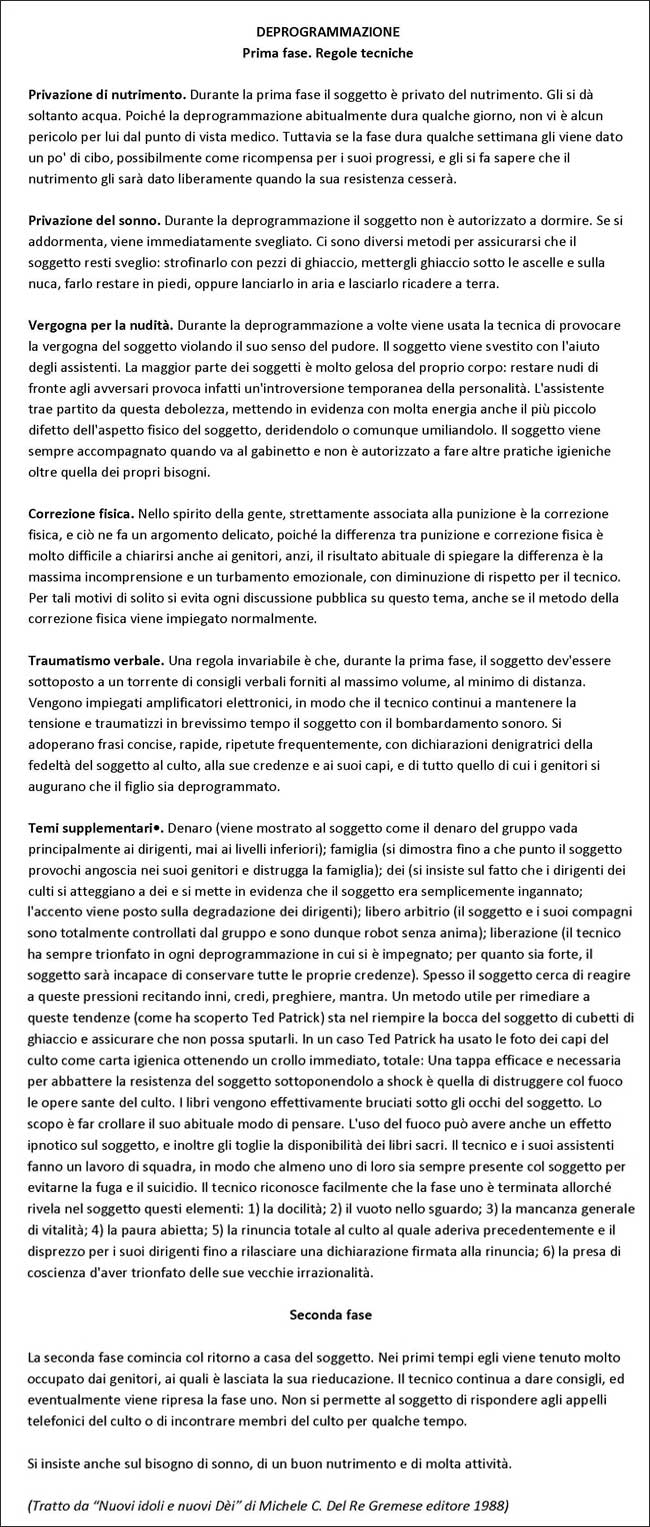
Translation of the two pages above:
DEPROGRAMMING
First phase. Technical rules
Deprivation of nourishment. During the first phase, the subject is deprived of nourishment. He is only given water. For the fact that deprogramming usually lasts some days, there is no danger for him from a medical viewpoint. However, if the phase lasts some weeks, he is given some food, possibly as a reward for his progresses, and he’s told that he will be freely provided with nourishment when stopping resistance.
Deprivation of sleep. During the deprogramming the subject is not authorized to sleep. If he gets asleep, he has to be waken up immediately. There are several methods to make sure that the subject remains awake: rubbing him with pieces of ice, or throwing him up in the air and let him fall to the ground.
Embarrassment for nakedness. Sometimes during the deprogramming the technique of provoking embarrassment in the subject is used, so as to violate his sense of decency. The subject is undressed with the help of the assistants. Most of the subjects are very jealous of their body: to remain naked in front of opponents, in fact, causes a temporary introversion of the personality. The assistant takes advantage of this weakness, pointing out even the smallest physical defect of the subject, ridiculing him or, in any case, humiliating him. The subject is always escorted when he goes to the toilette and he is not authorized to perform no other hygiene practices besides that of going to the toilette.
Physical correction. In people’s mind, the physical correction is tightly connected to physical coercion, and this makes it a delicate issue, because the difference between punishment and physical correction is quite difficult to clarify, even to the parents and, often, the usual result of explaining this difference is an utmost incomprehension and emotional upset, with a lowered respect for the technician. For these reasons, usually, any public discussion on this issue is avoided, even if the method of the physical correction is normally utilized.
Verbal traumatism. An unchanging rule is that during the first phase, the subject must be subjected to a flood of verbal advices, given at the highest volume and at the minimum distance. Electronic amplifiers are used so that the technician continues to maintain the tension and within a very short time, succeeds in traumatizing the subject with a thunderous bombing. Brief, rapid, repeated sentences are used with frequency, with derogatory statements about the thruthfulness of the subject to his faith, to his belief and to his leaders, about anything that the parents wish their son be deprogrammed from.
Supplementary issues. Money (the subject gets shown how the money of the group mainly goes to the executives, never at the lower echelons); family (the subject is shown the degree of anguish he is causing to his parents and how he is destroying his family); gods (it is to be stressed that the leaders of the cults assume a god-like attitude and that the subject has simply been cheated; stress is put on the degradation of the leaders); free will (the subject and his companions are totally controlled by the group and therefore they are robots without a soul); liberation: the technician has always succeeded in each deprogramming he undertook; strong as he may be, the subject won’t be able to maintain all his beliefs). Often the subject tries to react to these pressures chanting hymns, creeds, prayers, mantras. A useful method to make up for these tendencies is to fill the mouth of the subject with ice cubes and make sure he cannot spit them out. In one case Ted Patrick used the photographs of the cult’s leaders as toilette paper, achieving an immediate and total breakdown. An effective and necessary stage to knock out the resistance of the subject inducing a shock on him, is to destroy put on arson the holy texts of the cult. The books are actually burnt under the eyes of the subject. The purpose is to demolish his usual way of thinking. The use of fire can also have a hypnotic effect on the subject and, moreover, he won’t have the holy texts at his disposal. The technician and his assistants work as a team, so that at least one of them is always with the subject to avoid his escape and suicide. The technician easily recognizes that phase one is over when he observes the following indicators in the subject: 1) docility; 2) blank stare; 3) the lack of general vitality; 4) despicable fear; 5) total renunciation to the cult once he belonged to and contempt for its leaders, up to the point when he will release a written declaration of his renunciation; 6) his awareness of having triumphed over his old irrationalities.
Second phase
The second phase starts with the return home of the subject. During the first times he is kept very busy by the parents, who will have the task of re-educating him. The technician continues to provide advices, and as deemed, phase one gets re-started. The subject is inhibited from answering the phone appeals of the cult’s members for some time.
Stress is also put on the need of sleep, good nourishment and many activities.
(Excerpt from “New Idols and New Gods” of Michele C. Del Re – Published by Gremese 1988)
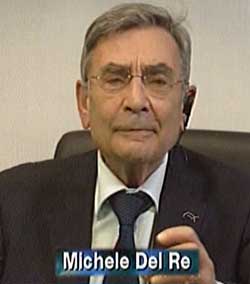 A coercive “method”, therefore, to compel a person to recant his ideas and beliefs against her will. This method was put into practice on Alessandra and would have come to its rawer expressions, if she had not pretented to cooperate and had not ran away from her kidnappers with a stratagem.
A coercive “method”, therefore, to compel a person to recant his ideas and beliefs against her will. This method was put into practice on Alessandra and would have come to its rawer expressions, if she had not pretented to cooperate and had not ran away from her kidnappers with a stratagem.
The author of this book (and of several others on the subject of plagiarism on the part of “cults”) is the founder and president of the Centro Studi Nuovi Culti Emergenti, headquartered in Rome.
Former professor of criminal law at Camerino University, he was for many years a consultant to the SISDE (today AISI, in practice the Italian Secret Services) on the issue of “cults” along with other members of the anti-cult world. The functions of SISDE on “cults” are now being carried out by S.A.S. (see “The Anti-Cult Squad”).
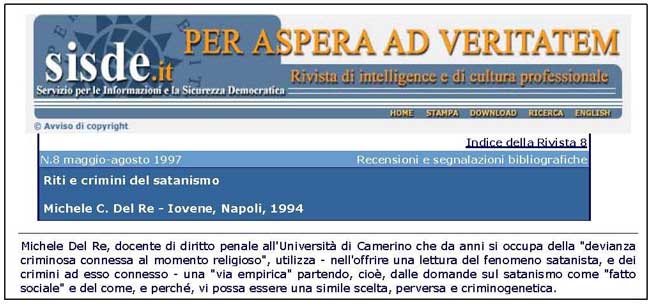
From the seizure of the documents of the Freemason Lodge P 2 in Castiglion Fibocchi, at the residence of Licio Gelli – ordered by the Anselmi Parliamentary Commission of Inquiry – it emerged that attorney Michele Del Re was a member of the lodge with card #661 (source Wikipedia: “List of members of the P2”). Heard by the Commission of Inquiry, Del Re explained that “he had infiltrated the P2, as well as other cults, because he was doing a study commissioned and funded by the CNR (National Research Center)”.
Del Re has also been the attorney of Ennio Malatesta and ARIS at the time of Alessandra’s kidnapping.
As we will see later, Del Re was also involved in the kidnapping of Alessandra for “study purposes” but he was excluded from the investigation.
In her complaint Alessandra has not specifically denounced her parents, but she merely explained the facts describing very clearly the role played by ARIS members Ennio Malatesta and Sergio Mandelli, of the deprogrammer Ted Patrick and of other characters present on the scene of her imprisonment. From the text of the complaint, and later on from the acts of the investigation, it became very clear that her parents had been misled by Malatesta, who got them scared with alarming news about alleged serious dangers that their daughter was running into.
Alessandra’s father even declared to the Prosecutor that he remained “very impressed” and “very much alarmed” watching a television broadcast hosting Malatesta and other ARIS members and that, after having tracked him down, he met “with Malatesta at least 15 times over a year”.
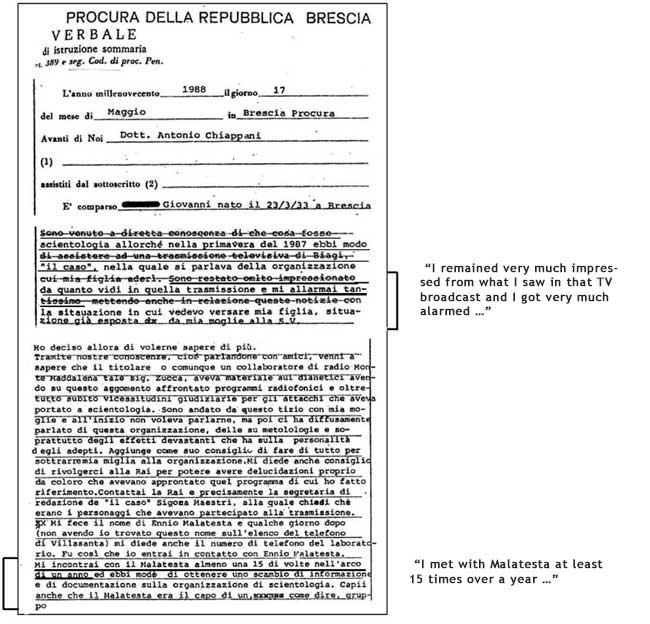
After the filing of the complaint, Alessandra constituted herself civil party in the proceedings that had to be started against her kidnappers, expressly specifying that she intended to exclude her parents and brother.
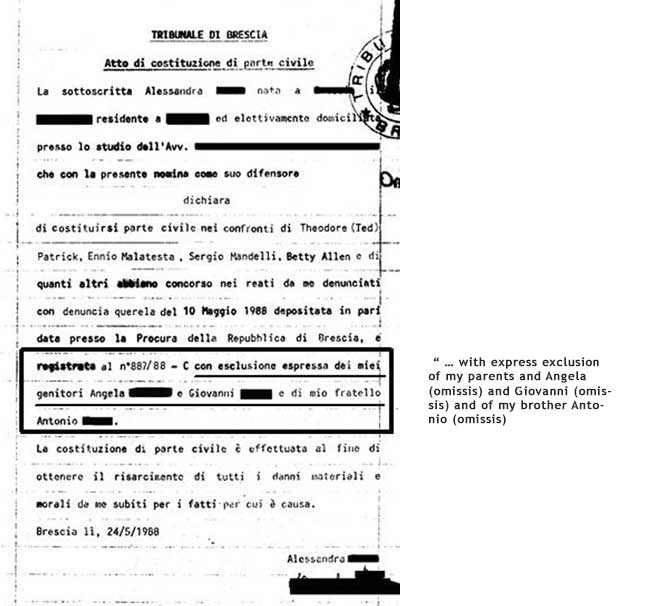
Despite this, the Deputy Prosecutor Antonio Chiappani, currently still on duty in the Prosecutor’s Office of Brescia, decided to include in the register of the suspects both Alessandra’s parents and brother and the members of ARIS Ennio Malatesta, Sergio Mandelli, Ted Patrick, Giorgio Antonucci and Dino Michieletto.
In doing so, the deprogrammers-kidnappers could use Alessandra’s parents – who have taken most of the responsibility – as a shield.
Dr. Chiappani started the investigation immediately, as evidenced by the acts of the proceedings. For example, he interrogated Alessandra’s mother on 14th May 1988, just four days after the daughter had filed the complaint.
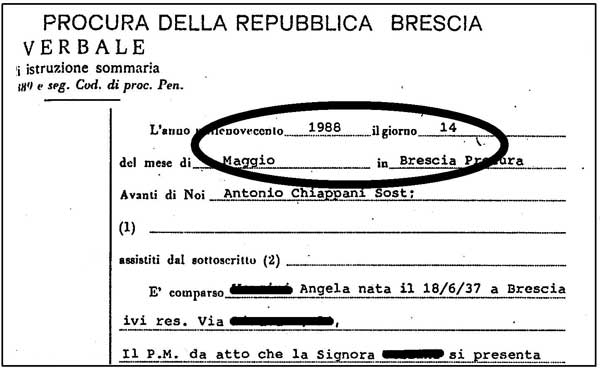
The matter was simple enough: the parents, alarmed by media news and information received directly from the President of ARIS, Ennio Malatesta, following his advice, deceived their daughter (Alessandra was 23 years old at that time) and brought her to a farmhouse in Tuscany to then turn her over to her jailers-deprogrammers, the chief of whom was Ted Patrick, a US citizen with a criminal background. Alessandra was retained by force in that place and subjected to the practice of deprogramming against her will. Escaped to her jailers, she denounced the facts to the Carabineers and to the Prosecutor’s Office of Brescia.
The defendants have not denied the facts; indeed they confirmed them all in detail, stating that it was a “necessary remedy”.
Despite the clarity of the facts, the investigation of Dr. Chiappani went on for almost three years, i.e. until March 9, 1991, date of his request for dismissal.
It could be assumed that thorough investigations were done on the kidnapping and on the self-confessed criminals, but this was not the case. What have the investigators done in those three years?
Shortly after Alessandra’ denunciation of the fact, Ted Patrick escaped out of the country with his accomplice Betty Allen. There is no evidence of investigations done on them; they had kidnapped and tortured an Italian citizen in her adulthood, but there is no trace of international rogatory letters or requests for information to the U.S. law enforcement agencies.
The investigation on Malatesta and the other members of ARIS Sergio Mandelli, Giorgio Antonucci and Dino Michieletto (Chiappani writes Micheletto without the second “i”; perhaps he did not even duly identify him) seem to have been limited to few formal interrogations without consequences.
As we briefly wrote earlier, attorney Michele Del Re was excluded from any investigation because, Dr. Chiappani says, he was on the scene of the kidnapping as a “scholar of this subject” to follow “the actual progress of such a practice” [sic].
However, the “suspects” were definitely traceable and in those days they boldly appeared on the media to advocate the usefulness and effectiveness of deprogramming.
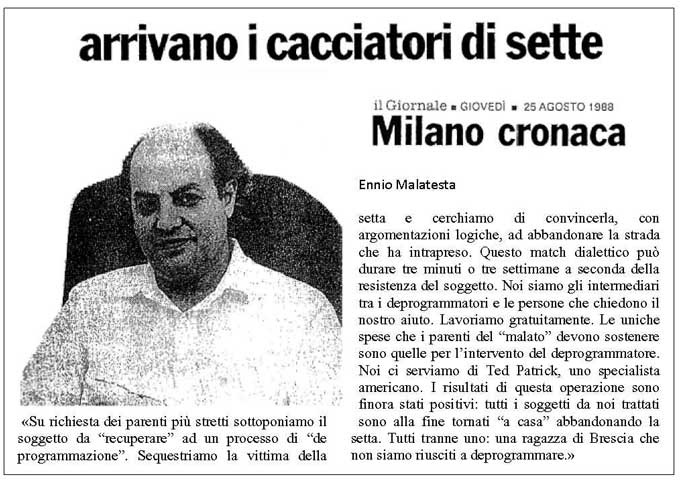
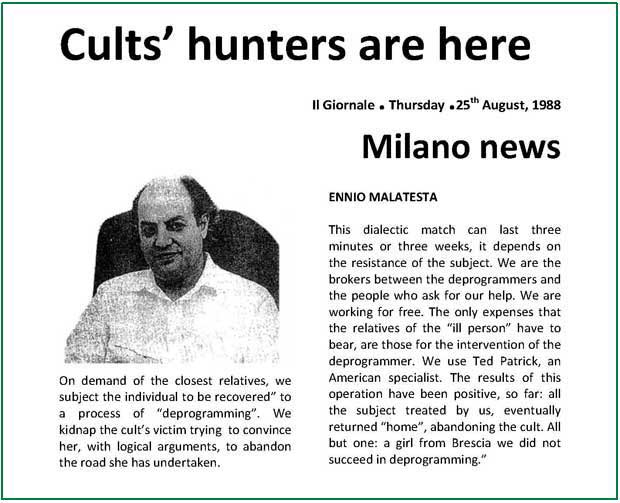
Alessandra’ parents were heard summarily in the period immediately after the filing of the complaint.
According to the documents, most of the investigations have not been carried out against Alessandra’s kidnappers, but on the Scientology movement if which Alessandra was a member.
In fact, making use of the judiciary police, Dr. Chiappani collected all what was available on Scientology in the archives of the Court of Brescia.
Here is a list of some of the reports collected by the Prosecutor, which have nothing to do with Alessandra’s kidnapping:
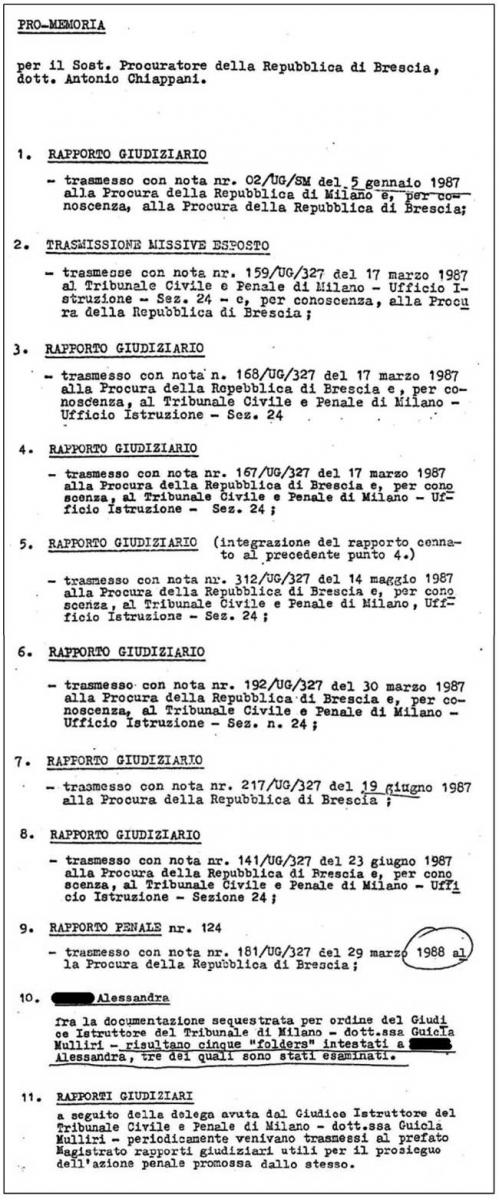
Malatesta, himself, while releasing media interviews, provided the investigating judge, through his defending attorney, with numerous documents to orient the investigations toward Scientology.
Here is, for example, a letter of the attorney of the defendants, Renato Bianchi, which was part of a file addressed to the Prosecutor:
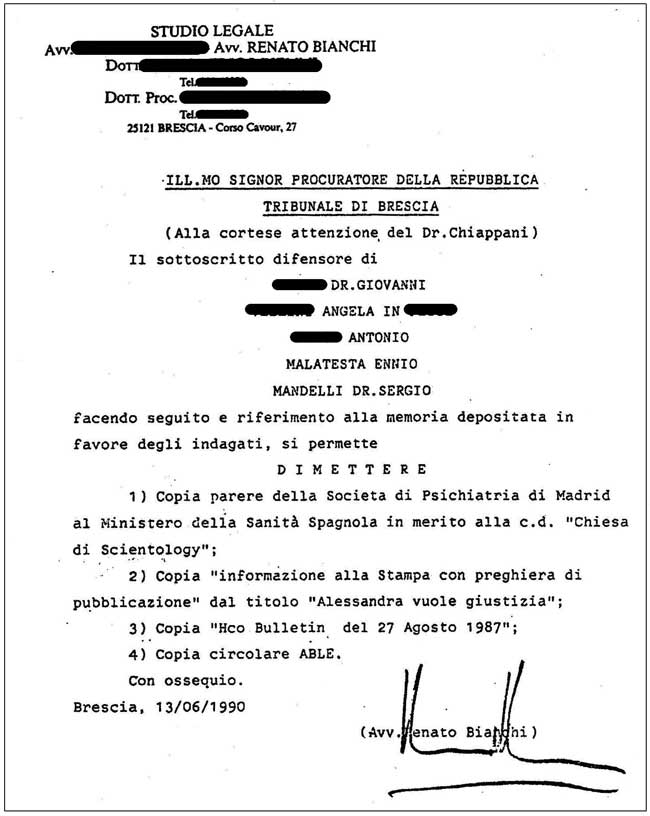
And here is a partial list of additional documents given to the Prosecutor by the legal counsel of the kidnappers:
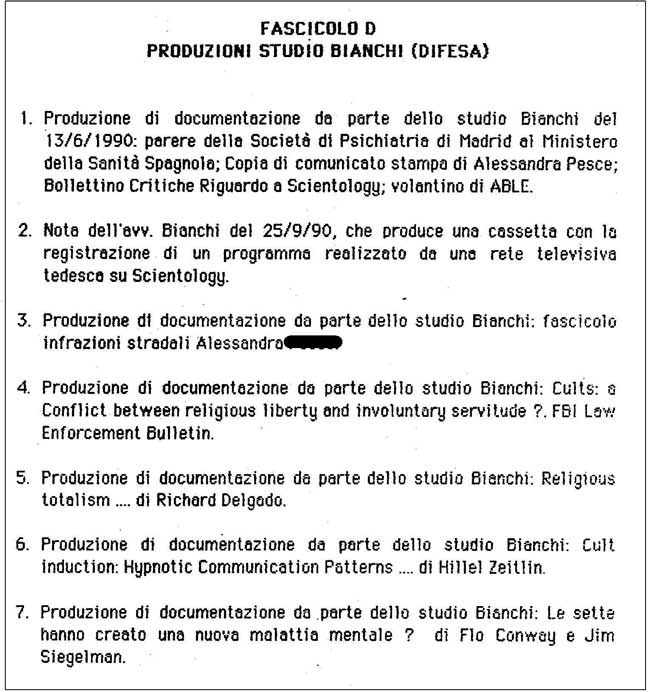
Prosecutor Chiappani’s tendency not to investigate Alessandra’s kidnappers but to look in other directions, was even more manifest when he appointed as Court experts on 14th July 1990 a psychologist and priest, Professor Costante Scarpellini and a psychiatrist, professor Mario Di Fiorino.
Although from the expert report title (below) it appears that the two Court experts had received the task of providing an opinion “on (omissis) Antonio [1] and others”, i.e. those charged with kidnapping and domestic violence,
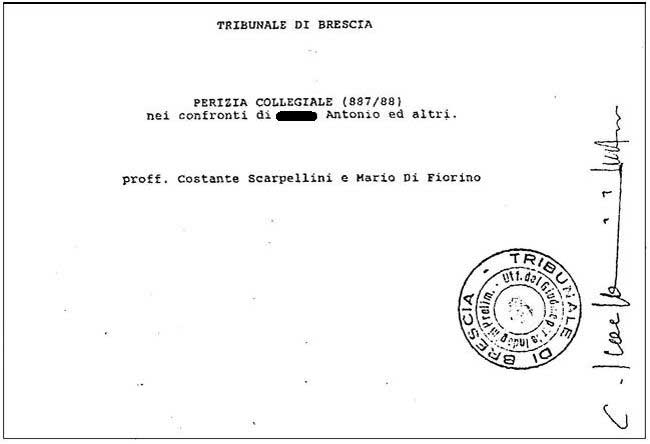
from the description that the two professors provided of such an expertise, it is clear that the questions posed by Doctor Chiappani did not concern the defendants, but Scientology and Alessandra herself.
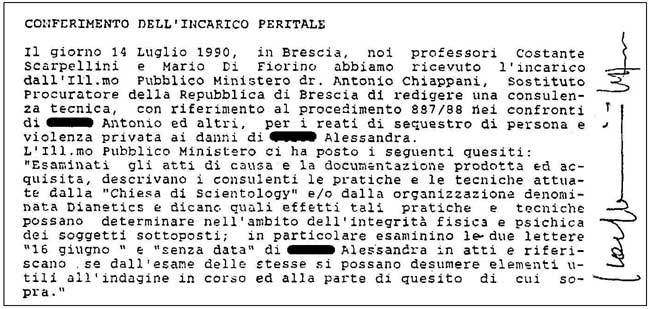
In fact, in the following 35 pages of the experts’ report, as many as 27 concerned the doctrine, the organization, the slang and the practices of Scientology. The last 8 pages, including the concluding remarks, related to Alessandra, or rather, to the two letters written by Alessandra.
The two experts, in reporting to the Prosecutor, stated that they had started the expertise not by examining the documents related to the investigation toward the defendants, but “the abundant documentation produced” by the defendants’ attorney and the “psycho-pathological literature on cults”.
On the other hand, despite the headline appearing on the court ordered expertise (technical advice “against … Antonio and others for the crimes of kidnapping and domestic violence) the questions posed by Doctor Chiappani asked to evaluate Alessandra and the group to which she was affiliated. His request did not include any assessment of the defendants and of their conduct.
In practice, the plaintiff found herself under investigation and her kidnappers, rather than being defendants, were treated as collaborators of justice, indeed, prosecution advisors.
The conclusion of the two experts was that the practice of Scientology can lead to “developments of paranoid nature (true delusional syndromes) that can develop in prone personalities”.
Apparently, from the examination of the two letters of Alessandra, without ever having heard or visited her, the two experts established that she was a “personality prone” to suffer harms that, according to them, Scientology can cause. In fact, again according to the two letters analyzed, they established that Alessandra:
“was in a state of:
1) a great deal of uncertainty, even if controlled,
2) severe emotional disappointment,
3) dissatisfaction for the work situation,
4) adolescent search of herself, because she did not yet know herself”
So they concluded:
“This data argues in favor of a personality of great weakness and therefore, one at risk.”
The two experts, aware that their expertise was based on insufficient material, at least with regards to Alessandra, added in the conclusions of their work that with just the “examination of the letters” it was not “possible to express a reliable opinion” and that “only a thorough clinical examination, with the use of appropriate psycho-diagnostic tests, would make possible – in their opinion – a technical evaluation of it. Only a thorough clinical examination, with the use of appropriate psycho-diagnostic tests, would make possible – in their opinion – a technical evaluation of it.”
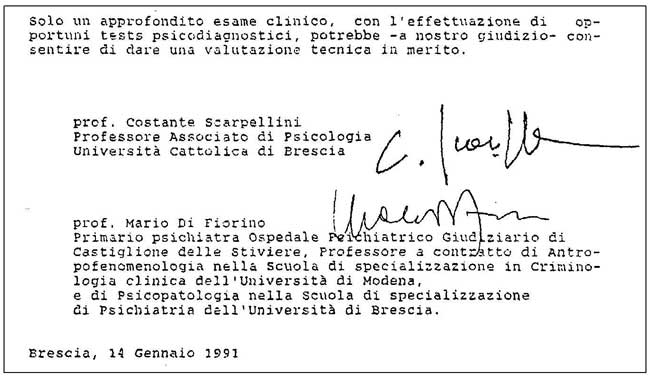
On the other hand, as they pointed out, they only had at their disposal two letters and they could not, or did not want, to put Alessandra under a “thorough clinical examination” and carry out “appropriate psycho-diagnostic tests”, nor the Prosecutor ordered them to do it.
Their conclusions – far from exhaustive – are based on the contents of a letter written two years before to her brother, who was serving his military service at that time; the second letter, unbeknownst to the experts and the prosecutor, had been integrally written by her attorney, who was anything but “a personality of great weakness and, therefore, one at risk.”
IDoctor Chiappani was instead satisfied with the work done by the experts, to the point that he based his conclusions – in favor of the kidnappers – on the “unmistakable and very serious results reached by the technical expertise ordered by this Public Prosecutor.”
However, despite the rather weak conclusions of the unsatisfied body of experts and the glaring omission of the police investigation, a few weeks later, prosecutor Antonio Chiappani asked for the dismissal of the investigation.
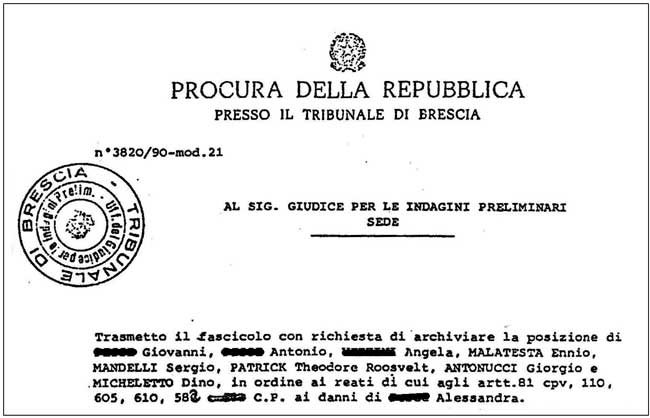
An adult woman escaped her kidnappers, full of hope she turned to justice to report having suffered kidnapping and physical violence, but nothing was done to investigate the facts she denounced, on the contrary, she found herself under investigation. The magistrate did not investigate the main defendants, did not verify their criminal background (and they had one), did not reconstruct the events in order to understand exactly what had happened, he did not investigate the scene of the kidnapping, he did not question the owners of the Tuscan farmhouse where the plaintiff was held in captivity to see if they were accomplices or not, he did not check if in that place other offenses had been committed, he did not hear the doctors of the emergency ward that medicated the woman after her escape, he did not hear witnesses who might have shed light on the personality of the defendants, he did not order psychiatric or psychological expertises to be done on the defendants, he did not try to track down the two foreign kidnappers escaped after the complaint. None of this.
The three-year long investigation of doctor Chiappani can be summarized in the following acts:
1) summary interrogations of the defendants,
2) collection of document produced by the defense which were taken from the judicial archives on topics other than the facts denounced and
3) technical opinion of professors Scarpellini and Di Fiorino solely based on documents that had nothing to do with the crimes committed by the defendants.
On the basis of these few investigative acts, without having heard nothing but the voice of the defendants and having just consulted documentation clearly hostile to the plaintiff and to her beliefs, he concluded that this was enough to justify a kidnapping, describing him as legitimate defense.
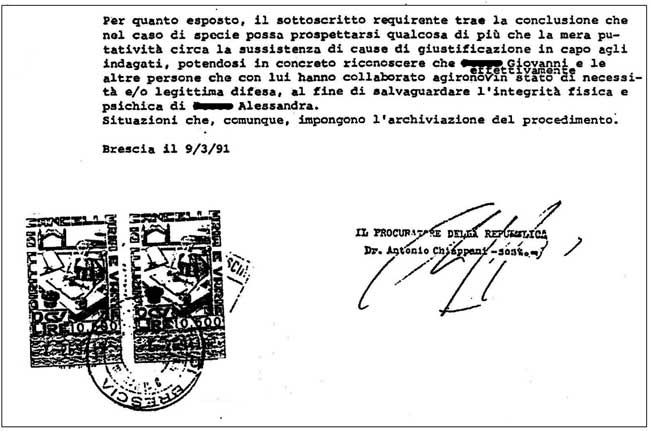
Way back in that 1988, while Chiappani was starting his investigation, an investigating magistrate from Milano was completing her broad and long investigation against a hundred of leaders and followers of Scientology, issuing a very long order of prosecution (about 1,300 pages).
As one can see by the memorandum on the judicial reports above published, doctor Chiappani was since time following the proceedings in Milano and had put on record the acts of the order of prosecution of that magistrate, describing it as a “monumental and exhaustive document.”
Apparently, prosecutor Chiappani had fully embraced the accusation theories of the Milanese magistrate, reiterated by the attorneys of the defense and supported by the technical experts Scarpellini and Di Fiorino.
Also the judge for the preliminary investigations Roberto Spanò, from what he wrote in his decree of shelving dated 18 March 1991, upheld such arguments, even stating that Alessandra was a “victim, more than of her parents, of the methods and practices of Scientology.”
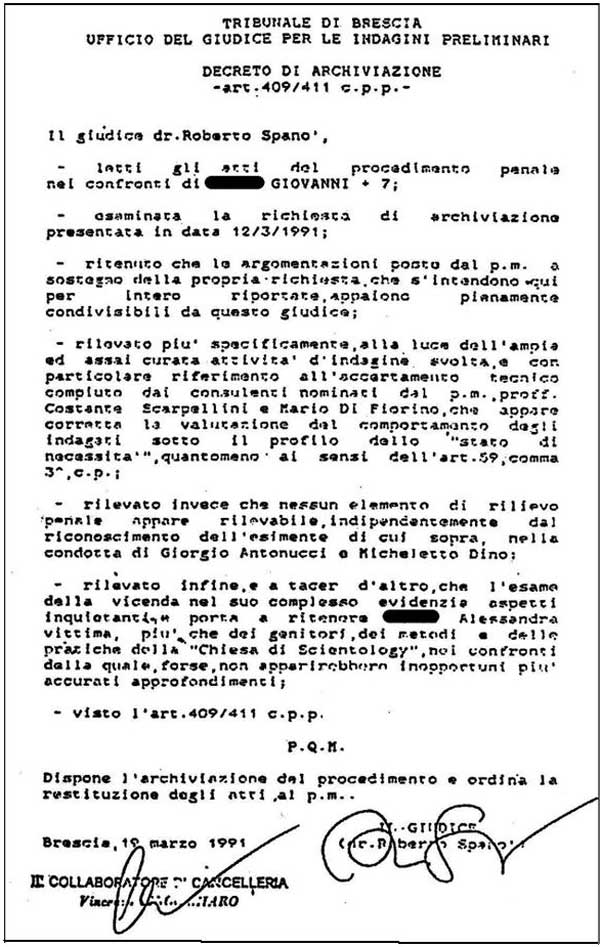
In their rulings, both the magistrates passed over a point that, according to us, is important: if they wanted to use the justification of the “putative state of necessity” to the parents (that Alessandra had in any case requested to exclude from the proceedings), how could they ignore the responsibility of people like Ted Patrick, Betty Allen, Ennio Malatesta and Sergio Mandelli that certainly did not have that necessity and who were the physical perpetrators of the kidnapping?
On the basis of this theory, any kidnapper could get away with it, provided he uses as a shield a parent claiming to be in a “state of necessity.”
Another thing that the magistrates from Brescia could not forecast is that, as the authoress of this article, writes, “all or almost all the accusation theory of the Judge of Investigation of Milan did not stand the examination of the First Instance magistrates. The maxi-trial of Milano against Scientology is now history and the third Court of Appeal confirmed the First Instance decision, with which the defendants were acquitted from the main charge, on which all the theorem of the accusation had been based: that of criminal conspiracy.” [2]
From other documents, made available by the injured party, details have emerged that seems of interest to us to better understand certain mechanisms of this kidnappers-saving investigation.
For example, the person charged with kidnapping and president of ARIS, Ennio Malatesta, was concurrently a leading figure also in Milanese investigation. When interrogated repeatedly by the Investigating Judge Guicla Mulliri, he provided her with a large mass of documents, just as he was doing with the prosecutor of Brescia.
Through his association Malatesta tried, unsuccessfully, to become a civil party in the Milanese trial along with other 21 individuals affiliated to ARIS, among whom, Dino Michieletto and Giorgio Antonucci, his accomplices in the kidnapping of Alessandra and therefore his co-defendant in Brescia. [3]
From a video that was recently brought to our attention, we excerpted this interesting budget sent by ARIS to a prominent Member of Parliament (English translation at the bottom).
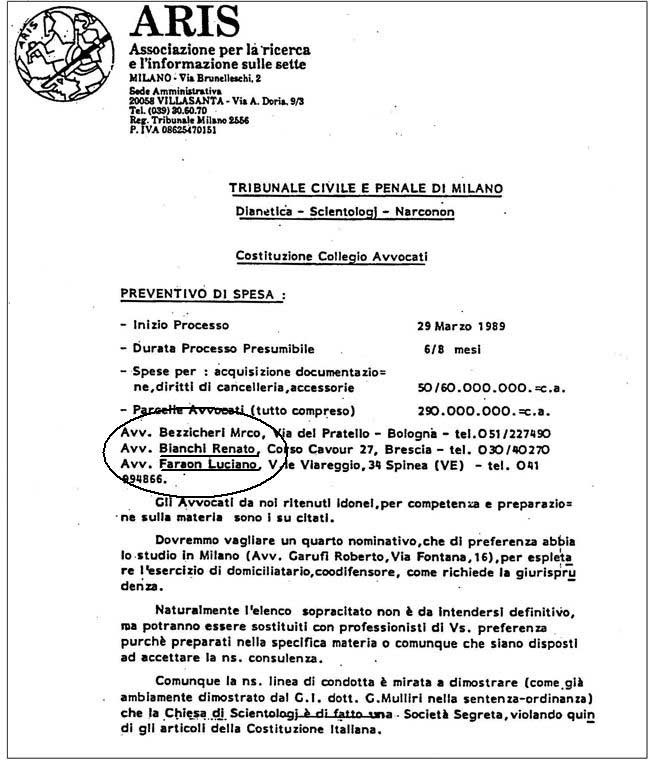
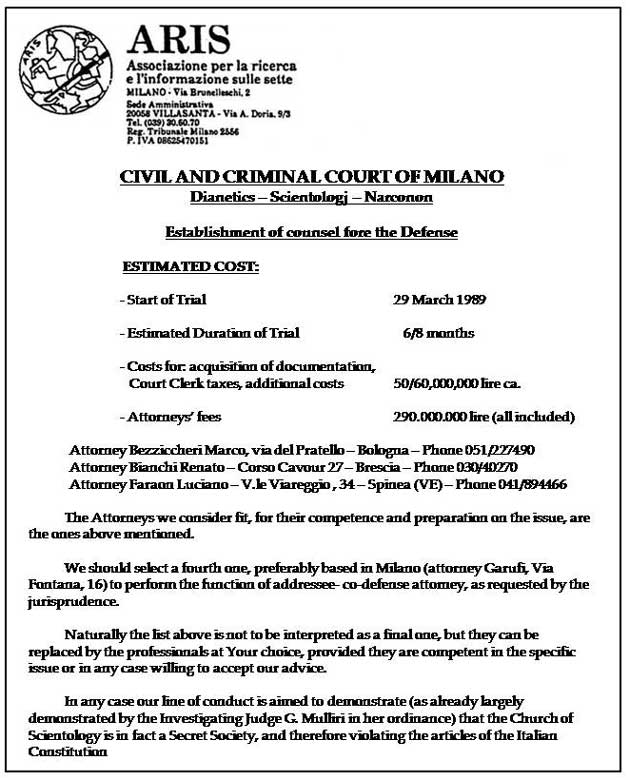
The attorney Renato Bianchi mentioned in the document is the same one that was defending in Brescia the president of ARIS Ennio Malatesta and his associates Mandelli, Antonucci and Michieletto from the charge of kidnapping.
With regards to attorney Luciano Faraon – already convicted for fraud in 1996, for libel (with a final decision) in 1998, radiated from the Attorney Bar that same year and again suspended in 2011 – he was the attorney and member of ARIS Veneto.
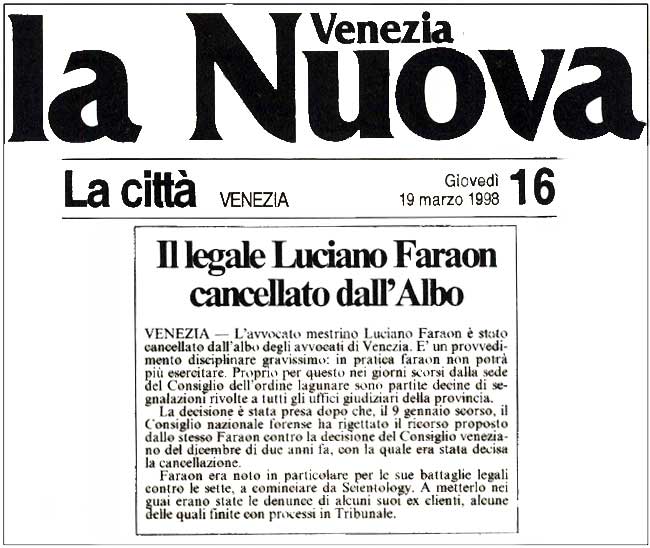
(English translation below)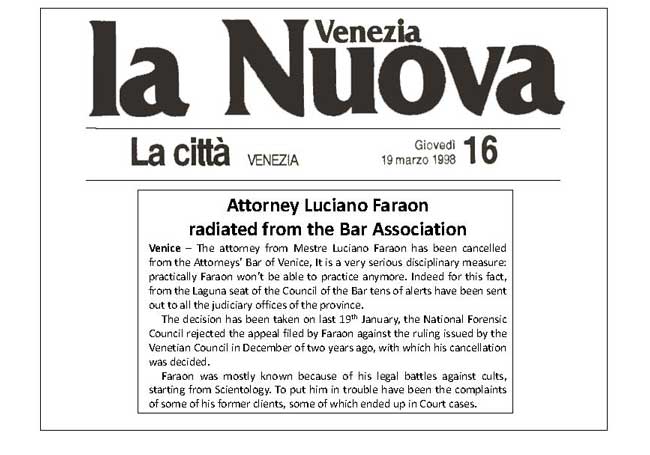
Michele Del Re, who visited the scene where Alessandra was imprisoned for “study reasons”, joined the defense team of Milano in a later moment.
We could say that Alessandra’s kidnappers and their attorneys, protagonists of Chiappani’s investigation, were concurrently actors in the Milanese proceedings from which the Prosecutor of Brescia got his “anti-cult” information and thesis, which the defendants themselves produced and supported on one hand to defend themselves from the charge of kidnapping, and on the other to spread a social alarm..
It therefore appears that doctor Chiappani formed his convincement on the wake of the Milanese Court case (later on surpassed by judgments which have dismantled the accusation theory) and the literature supplied by the defense.
In fact, in his request of dismissal of the case, he wrote that “the reading of the copious “Dianetics” material accompanying this case file, the content of the ample and penetrating memorandum of the defense, the poignant and meaningful literature attached to such a memorandum (…), not to mention the monumental and exhaustive document of the order-judgment of the proceedings #528/81-F, put on record (…) provide, to say the least, a disquieting scene (if not an anguishing one).”
But, as Chiappani said, what was decisive for him to reach the decision of dismissing the case, was the technical expertise of the professors Scarpellini and Di Fiorino. With regards to this point Chiappani stated that “within this contest and with reference to the case being examined, the outcomes and conclusions of the technical expertise take on (…) a peculiar relevance.”
An opinion that, few days after, judge Spanò shared dismissing the case.
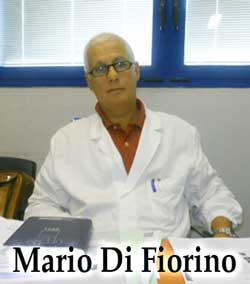 The most important part of the 37 pages of the expertise was developed by Di Fiorino. His colleague, professor Scarpellini, “limited himself” to evaluate the two letters of Alessandra (one of which written by her attorney), from a psychological viewpoint, while professor Di Fiorino developed all the part related to Scientology and Alessandra’s affiliation. Indeed in the part that Chiappani, Spanò and Alessandrini considered “exhaustive”, of “peculiar relevance”, “unequivocal” and “detailed”.
The most important part of the 37 pages of the expertise was developed by Di Fiorino. His colleague, professor Scarpellini, “limited himself” to evaluate the two letters of Alessandra (one of which written by her attorney), from a psychological viewpoint, while professor Di Fiorino developed all the part related to Scientology and Alessandra’s affiliation. Indeed in the part that Chiappani, Spanò and Alessandrini considered “exhaustive”, of “peculiar relevance”, “unequivocal” and “detailed”.
The representatives of ARIS of that time knew well professor Di Fiorino and his unfavorable opinion about “cults”, and they knew he was favorable to the reintroduction of the crime of plagiarism/mental manipulation. They knew him well before Doctor Chiappani appointed him as a consultant (14 July 1990) in the proceedings were they were charged with kidnapping and domestic violence.
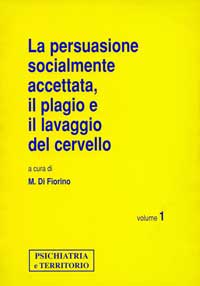 Since 1984 professor Di Fiorino has been the director of the magazine “Psychiatry and Territory” and was writing articles in favor of the reintroduction of the crime of plagiarism in our legal system advocating the existence of brainwashing and mental manipulation on the part of “cults”.
Since 1984 professor Di Fiorino has been the director of the magazine “Psychiatry and Territory” and was writing articles in favor of the reintroduction of the crime of plagiarism in our legal system advocating the existence of brainwashing and mental manipulation on the part of “cults”.
When prosecutor Chiappani appointed him as a technical expert, Professor Di Fiorino was already busy since years in producing and disseminating an unfavorable literature about “cults”, asserting they were plagiarizing their followers and practicing brainwashing.
It is not weird, then, that he concluded his expertise as above described. He did nothing but repeating concepts and ideas he had already expressed in several occasions, during congresses on this subject, in his articles and essays. It would be instead strange if professor Di Fiorino would have actually studied the materials collected during the investigation of doctor Chiappani, seen that surely he had already at his disposal a broad literature on this issue, well before being appointed as a Court expert by the Prosecutor.
But there is more to know. During his activity, Professor Di Fiorino had already entertained relationships with ARIS, Malatesta and the other people charged with Alessandra’s kidnapping.
It dates back to 1st and 2nd September 1989 – for example – the congress held in Forte dei Marmi with a title that, since that time, became the name of a series of publications of Professor Di Fiorino: “The socially accepted persuasion, the plagiarism and the brainwashing”. It was held at the Congress Center of Hotel Versilia Holidays, on behalf of the organization “Psychiatry and Territory” and with the cooperation of various representatives of ARIS and GRIS, the latter the anti-cult group of the Episcopal Conference.
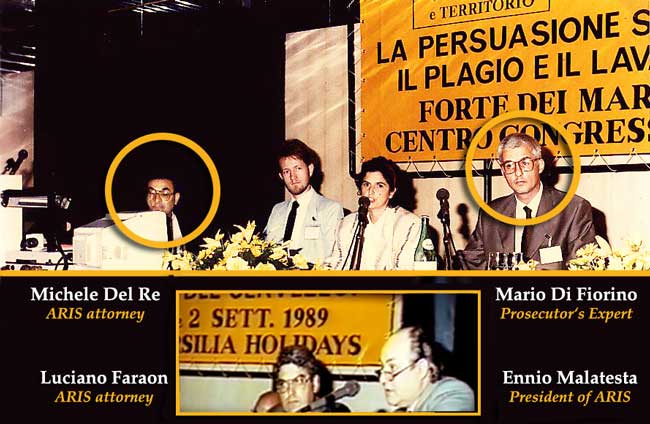
The congress was attended also by attorney Del Re and by the members of ARIS Dino Michieletto, Luciano Faraon and Giorgio Antonucci.
At that time prosecutor Chiappani had not yet entrusted professor Di Fiorino with the task of doing a technical expertise on the investigation related to the kidnapping, but the kidnappers had already committed the crime and were already under investigation for kidnapping and domestic violence.
aking into account all said so far, it is at least hypocritical that Alessandrini – in the letter “IN ORDER TO MAKE CLARITY ON A CASE OF DEPROGRAMMING IN ITALY” (http://favisonlus.wordpress.com/2012/11/26/per-fare-chiarezza-su-un-caso-di-deprogrammazione-in-italia/), that he wrote on behalf of the Anti-Cult Forum of which ARIS and Malatesta are members – wanted to point out that “the defendants of the Brescia trial, were all acquitted from the charge of kidnapping, domestic violence and intentional injuries, on the basis of a detailed psychiatric expertise that led the prosecutor to ask for the acquittal”.
Alessandrini and the members of ARIS were certainly aware of the role played in this vicissitude by the expert Professor Di Fiorino.
In the next and last act we will further study in depth the intrigues of the so called “court expertise”. We will see also other details, unknown so far to most of the people, like for example the common interests shared by ARIS kidnappers, the court expert professor Di Fiorino and the various anti-cultists.
Aprile 14, 2013
oOo
Notes:
1) Antonio is Alessandra’s brother. In the previous deeds, the prosecutor was acting against Alessandra’s father (Giovanni): The brother was a co-defendant, but in the expertise there is no reference to the father as main defendant.
2) Here’s an article that summarized and analyzed the judicial proceedings: www.diritto.it/materiali/penale/jasonni.html
3) The civil party constitutions of ARIS were excluded from the proceedings during the preliminary phases of the First Instance trial.
